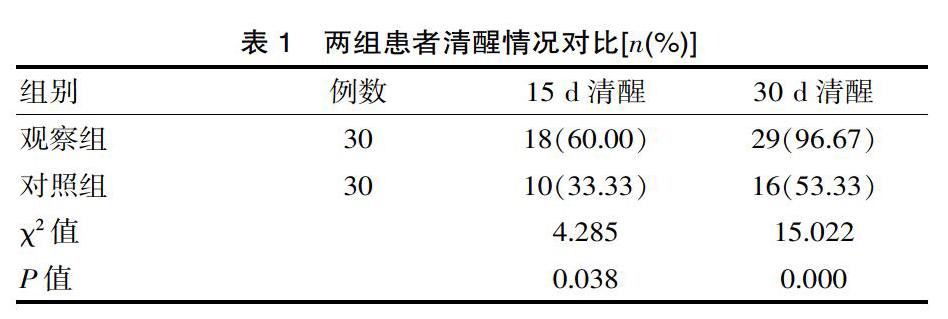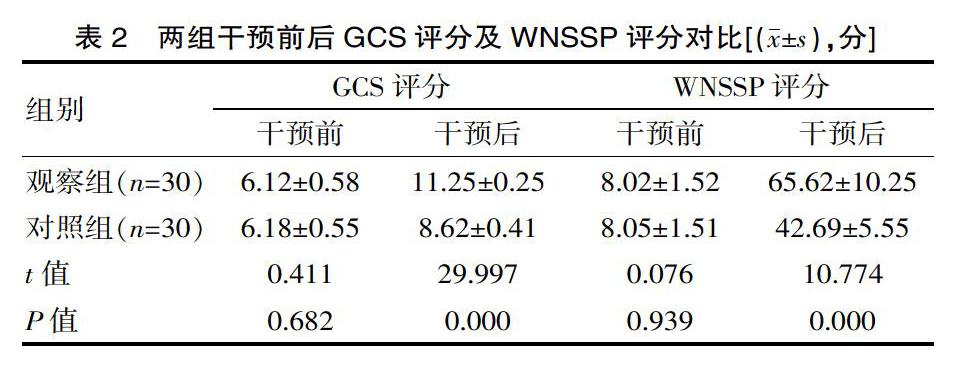感觉刺激对ICU重症颅脑损伤昏迷患者的促醒作用分析
谢莉莉 陈翰 江雪冰 陈斯静



[摘要] 目的 探讨感觉刺激对ICU重症颅脑损伤昏迷患者的促醒作用。方法 方便选取2017年2月—2019年3月ICU收治的重癥颅脑损伤昏迷患者60例进行研究,随机分为对照组与观察组各30例,对照组接受常规护理,观察组在对照组基础上实施感觉刺激,对两组患者清醒时间、格拉斯昏迷评分量表(GCS)、西方神经感觉刺激参数量表(WNSSP)进行观察。结果 观察组15 d清醒率、30 d清醒率分别为60.00%、96.67%,与对照组33.33%、53.33%比较,差异有统计学意义(χ2=4.285、15.022,P<0.05);两组干预前的GCS评分及WNSSP评分差异无统计学意义(P>0.05),观察组干预后GCS评分(11.25±0.25)分及WNSSP评分(65.62±10.25)分均高于对照组(t=29.997、10.774,P<0.05);观察组干预后的格拉斯哥预后(GOS)分级明显优于对照组(P<0.05)。结论 感觉刺激用于ICU重症颅脑损伤昏迷患者促醒中效果满意,具有推广价值。
[关键词] 感觉刺激;ICU;重症颅脑损伤昏迷;促醒
[中图分类号] R651.1+5 [文献标识码] A [文章编号] 1674-0742(2019)10(c)-0157-03
[Abstract] Objective To investigate the effect of sensory stimulation on the wakefulness of ICU patients with severe craniocerebral injury. Methods Convenient selected a total of 60 patients with severe craniocerebral injury who were admitted to the ICU from February 2017 to March 2019 were enrolled. The patients were randomly divided into the control group and the observation group. The control group received routine nursing care. The observation group was based on the control group. Sensory stimulation was performed and the awake time, the Grasse Coma Rating Scale (GCS), and the Western Neurosensory Stimulation Parameter Scale (WNSSP) were observed. Results The 15 d awake rate and the 30 d awake rate of the observation group were 60.00% and 96.67%, respectively, which were statistically significantly different from the control group (33.33%, 53.33%) (χ2=4.285, 15.022, P<0.05). There was no statistically significant difference in WNSSP scores before intervention(P>0.05). The GCS scores (11.25±0.25) points and WNSSP scores(65.62±10.25) points in the observation group were higher than in the control group(t=29.997, 10.774, P<0.05). The Glasgow Prognosis (GOS) grade after group intervention was significantly better than the control group (P<0.05). Conclusion Sensory stimulation is satisfactory for the recovery of ICU patients with severe craniocerebral injury and coma.
[Key words] Sensory stimulation; ICU; Severe craniocerebral injury coma; Waking up
重症颅脑损伤是ICU常见危急重症,具有极高的死亡率及致残率,近年来,随着医疗技术的发展,重症颅脑损伤患者病死率得以下降,但是长期昏迷数量增多,成为ICU护理亟待解决的问题。有研究证实,重症颅脑损伤患者因下丘脑与脑干、皮层等受损,会产生意识障碍,其昏迷时间越长,并发症发生率越高,预后越差[1]。因此,对ICU重症颅脑损伤患者采取积极措施促醒,缩短患者昏迷时间,有助于改善预后。该研究方便选取2017年2月—2019年3月该院收治的60例患者为研究对象,将感觉刺激用于ICU重症颅脑损伤昏迷患者护理中,对其促醒效果进行评估,报道如下。
1 资料与方法
综上所述,感觉刺激用于ICU重症颅脑损伤患者促醒中效果满意,可缩短患者清醒时间,改善其神经功能,具有推广价值。
[参考文献]
[1] 仲悦萍,张云,陈晓艳, 等.护士和家属实施感觉刺激对重型创伤性颅脑损伤昏迷患者促醒作用的比较[J].中华现代护理杂志,2018,24(31):3793-3797.
[2] 孙航,邵艳霞,孙溦.音乐疗法对颅脑损伤昏迷患者意识影响的研究[J].重庆医学,2017,46(34):4892-4894.
[3] 林伟琼,罗彩娟,吴凤英.刺激性护理干预对重型颅脑损伤昏迷患者促醒作用探讨[J].按摩与康复医学,2018,9(4):70-71.
[4] 徐茜,耿钰娟.多感官综合促醒模式对ICU病房脑性昏迷患者意识觉醒及预后康复影响分析[J].影像研究与医学应用,2018,2(18):224-225.
[5] 金红珍,徐希德,顧宇丹, 等.刺激性护理干预对创伤性脑损伤昏迷病人促醒效果和神经功能恢复的影响[J].护理研究,2017,31(12):1460-1463.
[6] 丁锦荣,吴德模,管义祥, 等.正中神经电刺激对急性颅脑损伤昏迷患者脑血流及促醒效果的影响[J].创伤外科杂志,2018,20(12):884-886.
[7] 张帆,吴苗苗,黄玉如.“唤醒服务链”对颅脑损伤昏迷患者的促醒效果及家属的知晓率调查[J].中国药物与临床,2018, 18(8):1299-1301.
[8] 孔洋洋,何高利,高丽丽.多种促醒方法联合应用对于重型颅脑损伤昏迷患者的效果观察[J].中国妇幼健康研究,2017, 28(S1):401-402.
[9] 张留静.味觉刺激对重型颅脑损伤昏迷患者促醒的效果研究[J].中国实用护理杂志,2016,32(10):760-762.
[10] 张平.刺激性护理对重型颅脑损伤的促醒效果评价[J].河南医学研究,2016,25(7):1344.
[11] 刘秀平.刺激性护理干预对重型颅脑损伤患者清醒时间及预后的影响[J].特别健康,2017,22(16):152-153.
[12] 代自烽,黄其林,刘海鹏,等.呼唤刺激对重型颅脑损伤昏迷患者促醒的临床研究[J].中华神经医学杂志,2016,15(4):397-402.
(收稿日期:2019-07-26)

